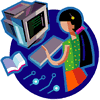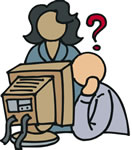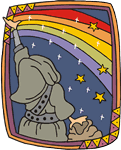Fall 2008 (volume 8, number 4)
Starters, Scaffolds and Sharing: Technology Across the Curriculum

Explore dozens of ways to integrate technology into practical, standards-based projects along with everyday activities. We’ll examine the popular new technologies along with reintroducing the most effective and efficient tools and resources from the past. Emphasis will be placed on realistic, time-saving approaches to maximize impact and learning across grade levels and subject areas. Learn More...
Graphic Novels, Photo Essays & Illuminated Term Papers: Communicating Deep Understandings
 From writing graphic novels to creating math comics, bring your class assignments, student projects, and course materials alive with 21st century approaches to communication. Regardless of whether you prefer Mac or Windows, you'll learn to use free online tools as well as inexpensive software to produce graphic novels, illuminated term papers, visual science reports, photo essays, and other engaging alternatives to traditional reports and student products. These concrete products reflect student understanding and provide a new way to think about assignments and assessment. In this workshop, we'll explore innovative ways to address essential standards across the curriculum while motivating reluctant students and promoting a love of reading and writing. Whether you're looking for fun ways to teach language or new approaches to address the diverse needs of today's students, you'll find lots of ideas in this fast-paced hands-on workshop. Learn More...
From writing graphic novels to creating math comics, bring your class assignments, student projects, and course materials alive with 21st century approaches to communication. Regardless of whether you prefer Mac or Windows, you'll learn to use free online tools as well as inexpensive software to produce graphic novels, illuminated term papers, visual science reports, photo essays, and other engaging alternatives to traditional reports and student products. These concrete products reflect student understanding and provide a new way to think about assignments and assessment. In this workshop, we'll explore innovative ways to address essential standards across the curriculum while motivating reluctant students and promoting a love of reading and writing. Whether you're looking for fun ways to teach language or new approaches to address the diverse needs of today's students, you'll find lots of ideas in this fast-paced hands-on workshop. Learn More...
Let’s Go! Google Earth and GIS Resources Across the Curriculum
 From virtual hikes to global investigations, learn to design content area activities that infuse relevant real-world data sources using Google Earth and Geographic Information Systems. In this session, you'll learn to use Google Earth and apply a variety of GIS resources across the K-12 curriculum.
From virtual hikes to global investigations, learn to design content area activities that infuse relevant real-world data sources using Google Earth and Geographic Information Systems. In this session, you'll learn to use Google Earth and apply a variety of GIS resources across the K-12 curriculum.
Bring literature alive through visualizing the settings of picture books and novels. Add relevance to social studies, science, and math activities with access to endless real-world data sources. Enrich cultural and language studies with an exploration of geography and travel. Immerse young people in history by following the Oregon Trail, tracking the movement of troops through conflicts, and imagining life on the Silk Road using satellite images, photographs, and maps. Connect place-based learning with global exploration for an engaging, interdisciplinary approach that addresses both standards and individual learning needs. Learn More...
GPS Devices and Place-based Learning Across the Curriculum
 With both GPS devices and learning, it’s important to start where you are. This workshop combines technology with place-based learning to promote REAL (Relevant, Engaging, Authentic Learning) experiences. Explore the many ways GPS devices can be integrated into classroom along with community-based activities. Try out endless project ideas and curriculum connections.
With both GPS devices and learning, it’s important to start where you are. This workshop combines technology with place-based learning to promote REAL (Relevant, Engaging, Authentic Learning) experiences. Explore the many ways GPS devices can be integrated into classroom along with community-based activities. Try out endless project ideas and curriculum connections.
Place-based education connects schools with the local community by grounding learning in local phenomena and lived experiences. Rooted in Dewey’s focus on authentic learning, placed based approaches include cultural and historical studies, nature exploration, and real-world problem solving. Students use technology including GPS to mark, trace, track, identify, coordinate, and conduct experiments. In addition to many classroom activities, the workshop will explore Geocaching, benchmarking, and other established GPS-based projects.
The morning will be spent exploring the possibilities for place-based learning and learning the basics of GPS use. In the afternoon, we'll be out in the community trying out reading, writing, art, music, social studies, math, science, and health activities you can use with young people of all ages. Come join the fun and bring learning alive for your students. Learn More...
Recipes for Success: Hot Technologies to Spice Up Your Library Progam
 Blogs, podcasts, wikis, webcomics, and social networks are just a few of the ingredients of today's technology-rich library programs. It's easy to get caught up in the "coolness" of technology, so it's essential that we step back and look at programmatic reasons for infusing technology. Let's explore two questions that school, academic, public, and special libraries are facing: How can technology help us address specific needs? In what ways, can technology generate interest and enthusiasm in our programs? This session explores a dozen key technologies along with important issues and practical strategies for their use. How will you "spice up" your program with emerging technology? Learn More...
Blogs, podcasts, wikis, webcomics, and social networks are just a few of the ingredients of today's technology-rich library programs. It's easy to get caught up in the "coolness" of technology, so it's essential that we step back and look at programmatic reasons for infusing technology. Let's explore two questions that school, academic, public, and special libraries are facing: How can technology help us address specific needs? In what ways, can technology generate interest and enthusiasm in our programs? This session explores a dozen key technologies along with important issues and practical strategies for their use. How will you "spice up" your program with emerging technology? Learn More...
SCORE IT with Graphic Inquiry, Standards, and Deep Thinking
 We live in a high-tech, multimedia world, yet most of our classroom activities still emphasize print communication. Even inquiry-based approaches to learning often stress writing lists of questions, reading texts, and writing papers. We know that many of our young people are motivated by graphic communications. There’s a need to explore the potential of graphic inquiry in teaching and learning. Use technology to support graphic inquiry to address standards and promote deep thinking. This winning combination focuses on Storytelling, Communication, Organization, Representation, Evidence. Learn More...
We live in a high-tech, multimedia world, yet most of our classroom activities still emphasize print communication. Even inquiry-based approaches to learning often stress writing lists of questions, reading texts, and writing papers. We know that many of our young people are motivated by graphic communications. There’s a need to explore the potential of graphic inquiry in teaching and learning. Use technology to support graphic inquiry to address standards and promote deep thinking. This winning combination focuses on Storytelling, Communication, Organization, Representation, Evidence. Learn More...
Strong Nests, Successful Students: Skills & Strategies for 21st Century Learning
 Birds are constantly rebuilding and strengthening their nests. Strong nests provide a nurturing environment for chicks to grow. Are you building a strong foundation for your students? Explore practical ideas and strategies for addressing the skills needed by 21st century learners. Through collaborations among media specialists, technology coordinators, and classroom teachers, we can motivate and challenge students across the curriculum. Learn More...
Birds are constantly rebuilding and strengthening their nests. Strong nests provide a nurturing environment for chicks to grow. Are you building a strong foundation for your students? Explore practical ideas and strategies for addressing the skills needed by 21st century learners. Through collaborations among media specialists, technology coordinators, and classroom teachers, we can motivate and challenge students across the curriculum. Learn More...

 Google is much more than a search tool.
Google is much more than a search tool.
 Use books for children and young adults as the focal point for technology-rich thematic activities. From historical fiction to contemporary issues, popular literature can bring reading and the world alive for students. By adding the power of Internet, educators can build information-rich thematic technology connections and practical classroom projects.
Use books for children and young adults as the focal point for technology-rich thematic activities. From historical fiction to contemporary issues, popular literature can bring reading and the world alive for students. By adding the power of Internet, educators can build information-rich thematic technology connections and practical classroom projects.  Where do you stand? Explore how school library media programs and other educators can address key issues related to intellectual freedom and social technology for young people.
Where do you stand? Explore how school library media programs and other educators can address key issues related to intellectual freedom and social technology for young people.  This online course (updated from an earlier version) explores ways to use the Internet to locate quality materials that will help you address individual differences in your classroom. In addition, ten tips are provided for connecting students to the learning environment through technology-rich resources.
This online course (updated from an earlier version) explores ways to use the Internet to locate quality materials that will help you address individual differences in your classroom. In addition, ten tips are provided for connecting students to the learning environment through technology-rich resources.  Let's address standards, challenge students, and instill a love of learning in young people through engaging, visually-rich resources and activities. Learn to integrate the growing body of quality print and web-based graphic reading resources for young people across the K12 curriculum. Beyond the superheroes of traditional comics, today's graphic communication projects help students synthesize and apply digital scraps, primary source documents, photographs, charts and graphics, and other visuals to create meaningful communications. Design standards-based activities that use traditional and emerging comic software such as Comic Life and online tools for producing graphic novels and other forms of sequential art for sharing students understandings and alternative assessment. With today's digital tools, you don't need to be a expert illustrator to use and create attractive and powerful digital comic projects across content areas.
Let's address standards, challenge students, and instill a love of learning in young people through engaging, visually-rich resources and activities. Learn to integrate the growing body of quality print and web-based graphic reading resources for young people across the K12 curriculum. Beyond the superheroes of traditional comics, today's graphic communication projects help students synthesize and apply digital scraps, primary source documents, photographs, charts and graphics, and other visuals to create meaningful communications. Design standards-based activities that use traditional and emerging comic software such as Comic Life and online tools for producing graphic novels and other forms of sequential art for sharing students understandings and alternative assessment. With today's digital tools, you don't need to be a expert illustrator to use and create attractive and powerful digital comic projects across content areas.  How do I help young people distinguish fact from fiction when the lines drawn by news and entertainment are often blurred? How do I determine the origin of information found on the web? What skills are needed to weigh arguments and draw conclusions? How are wikis created? Should wikipedia be used as an information source? The key to addressing these questions lies in helping students understand the inquiry process, how ideas are generated, and the process of tracing the origin of information. This session provides practical ideas and examples to help students manage the technology, evaluate information, and synthesize ideas to become information fluent.
How do I help young people distinguish fact from fiction when the lines drawn by news and entertainment are often blurred? How do I determine the origin of information found on the web? What skills are needed to weigh arguments and draw conclusions? How are wikis created? Should wikipedia be used as an information source? The key to addressing these questions lies in helping students understand the inquiry process, how ideas are generated, and the process of tracing the origin of information. This session provides practical ideas and examples to help students manage the technology, evaluate information, and synthesize ideas to become information fluent. 
 People often ask, how do you find all those great technology resources and ideas? How do you stay current when technologies change so quickly? How do you maintain a passion for teaching and learning?
People often ask, how do you find all those great technology resources and ideas? How do you stay current when technologies change so quickly? How do you maintain a passion for teaching and learning? Address standards, challenge students, and instill a love of learning in young people through engaging, innovative technology-rich resources and activities that don't take much time, but have high impact across content areas. Help students evaluate, synthesize and apply classroom content to address essential questions using digital scraps, primary sources, photographs, charts, graphs, audio, video, and other multimedia elements to create meaningful and powerful communications using free and low-cost tools. Transform the teaching and learning process!
Address standards, challenge students, and instill a love of learning in young people through engaging, innovative technology-rich resources and activities that don't take much time, but have high impact across content areas. Help students evaluate, synthesize and apply classroom content to address essential questions using digital scraps, primary sources, photographs, charts, graphs, audio, video, and other multimedia elements to create meaningful and powerful communications using free and low-cost tools. Transform the teaching and learning process!